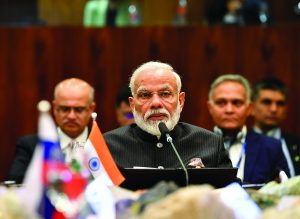 India eyes 5% GDP growth in 2020-21: World bank
India eyes 5% GDP growth in 2020-21: World bank
The World Bank in its latest report released on January 8, 2020 has lowered India’s GDP growth to five per cent for the fiscal year 2020-21 from its earlier estimated six per cent. In the World Bank report “2020 Global Economic Prospects” its projection for India GDP in 2021-22 has also come down to just 5.8 per cent, indicating that economic recovery could take longer than expected.
Why slowdown
The World Bank said in its report “India, where weakness in credit from non-bank financial companies is expected to linger, growth is projected to slow to 5 per cent in financial year 2019-20, which ends March 31 and recover to 5.8 per cent the following fiscal year”.
The World Bank report shows that GDP projection of 5 per cent is the second lowest for India after it had predicted growth at 3.1 per cent in the financial year 2008-09 due to the global financial crisis.
Need for structural reforms
Commenting on the findings of the report, World Bank Group Vice President for Equitable Growth, Finance and Institutions, Ceyla Pazarbasioglu said policymakers should focus on broad-based growth through structural reforms and reduce overall poverty levels.
Among India’s neighbours, the WB report showed that Pakistan’s growth is expected to rise to three per cent while Sri Lanka’s GDP is expected to rise to 3.3 per cent. Bangladesh, however, seems to be in a bright spot as its GDP is predicted to ease to 7.2 per cent.
The report makes it clear that India has to boost up domestic consumption if it wants to achieve prime minister, Narendra Modi’s dream of a $5 trillion economy.
Ironically, downward forecast comes for India when World Bank reports says that global economic growth is forecast to edge up to 2.5 per cent in 2020 as investment and trade gradually recover from last year’s significant weakness but downward risks persist, the World Bank says in its January 2020 Global Economic Prospects. However, growth among advanced economies as a group is anticipated to slip to 1.4 per cent in 2020 in part due to continued softness in manufacturing.
Growth in emerging market and developing economies is expected to accelerate this year to 4.1 per cent. This rebound is not broad-based; instead, it assumes improved performance of a small group of large economies, some of which are emerging from a period of substantial weakness. About a third of emerging market and developing economies are projected to decelerate this year due to weaker-than-expected exports and investment.
“With growth in emerging and developing economies likely to remain slow, policymakers should seize the opportunity to undertake structural reforms that boost broad-based growth, which is essential to poverty reduction,” said World Bank Group Vice President for Equitable Growth, Finance and Institutions, Ceyla Pazarbasioglu. “Steps to improve the business climate, the rule of law, debt management, and productivity can help achieve sustained growth.”
Following its weakest performance since the global financial crisis, the world economy is poised for a modest rebound this year — if everything goes just right. Hanging over this lethargic recovery are two other trends that raise questions about the course of economic growth: the unprecedented runup in debt worldwide, and the prolonged deceleration of productivity growth, which needs to pick up to bolster standards of living and poverty eradication.
The gobal growth is set to rise by 2.5 per cent, a small uptick from 2.4 per cent as trade and investment gradually recover, the World Bank’s semi-annual Global Economic Prospects forecasts. Advanced economies are expected to slow as a group to 1.4 per cent from 1.6 per cent, mainly reflecting lingering weakness in manufacturing.
Emerging market and developing economies will see growth accelerate to 4.1 per cent from 3.5 per cent last year. However, the pickup is anticipated to come largely from a small number of large emerging economies shaking off economic doldrums or stabilizing after recession or turbulence. For many other economies, growth is on track to decelerate, as exports and investments remain weak.
Worrying factor
A worrying aspect of the sluggish growth trend is that even if the recovery in emerging economy growth takes place as expected, per capita growth will remain below the long term averages and will advance at a pace too slow to meet poverty eradication goals Income growth would in fact be slowest in the region where 56 percent of the world’s poor live.
There have been four waves of debt accumulation in the last 50 years. The latest wave, which started in 2010, has seen the largest, fastest, and most broad-based increase in debt among the four. While current low levels of interest rates mitigate some of the risks associated with high debt, previous waves of broad-based debt accumulation ended with widespread financial crises.
Policy options to reduce the likelihood of crises and lessen their impact should they materialize include building resilient monetary and fiscal frameworks, instituting robust supervisory and regulatory regimes, and following transparent debt management practices.
Productivity growth, a primary source of income growth and driver of poverty reduction, has slowed more broadly and steeply since the global financial crisis than at any time in four decades. In emerging market and developing economies, the slowdown has reflected weakness in investment and moderating efficiency gains as well as dwindling resource reallocation between sectors. The pace of improvements in many key drivers of labor productivity — including education and institutions — has slowed or stagnated since the global financial crisis.
Yet another aspect of the disappointing pace of global growth is the broad-based slowdown in productivity growth over the last ten years. Growth in productivity — output per worker — is essential to raising living standards and achieving development goals. The use of price controls is widespread in emerging market and developing economies. While sometimes used as a tool for social policy, price controls can dampen investment and growth, worsen poverty outcomes, cause countries to incur heavy fiscal burdens, and complicate the effective conduct of monetary policy. Replacing price controls with expanded and better-targeted social safety nets, reforms to encourage competition and a sound regulatory environment can be pro-poor and pro-growth.
How to rekindle growth?
How to rekindle productivity growth? The outlook for productivity remains challenging. Therefore, efforts are needed to stimulate private and public investment; upgrade workforce skills to boost firm productivity; help resources find the most productive sectors; reinvigorate technology adoption and innovation; and promote a growth-friendly macroeconomic and institutional environment.
Two other issues merit consideration in this edition of the outlook: adverse consequences of price controls and inflation prospects in LICs.
While price controls are sometimes considered a useful tool to smooth price fluctuations for good and services such as energy and food, they can also dampen investment and growth, worsen poverty outcomes, and lead to heavier fiscal burdens. Replacing them with expanded and targeted social safety nets alongside the encouragement of competition and an effective regulatory environment can be beneficial both to poverty eradication and to growth. And while inflation has declined sharply among low-income countries over the last 25 years, keeping it low and stable cannot be taken for granted.
Low inflation is associated with more stable output and employment, higher investment, and falling poverty rates. However, rising debt levels and fiscal pressures could put some economies at risk of disruptions that could send prices sharply higher.
Strengthening central bank independence, making the monetary authority’s objectives clear, and cementing central bank credibility are essential to keep prices anchored. If policy-makers manage to mitigate tensions and clarify unsettled issues in a number of areas — they could prove the forecast wrong by sending growth higher than anticipated.
CEBR Report
INDIA ACCELARATING
India is expected to become the fourth largest economy by 2026 and the third largest by 2034, according to a report by UK-based Centre for Economics and Business Research (CEBR). The same report observes that the USA in 2019 reached 24.8 per cent of world GDP, its largest share of the world economy since 2007. And the US is now expected to remain the world’s largest economy throughout the 2020s and is to be overtaken by China only in 2033
 The CEBR report states that India would surpass Germany to take on the mantle in 2026 and further topple Japan in 2034 to become the third largest economy. Referring to Prime Minister Narendra Modi-led government’s target of taking the economy to $5 trillion by 2024, the report said, “India is also set to reach a GDP of $5 trillion by 2026 – 2 years later than the current government target.”
The CEBR report states that India would surpass Germany to take on the mantle in 2026 and further topple Japan in 2034 to become the third largest economy. Referring to Prime Minister Narendra Modi-led government’s target of taking the economy to $5 trillion by 2024, the report said, “India is also set to reach a GDP of $5 trillion by 2026 – 2 years later than the current government target.”
The report stated that India would achieve its dream of reaching a gross domestic product (GDP) of $5 trillion by 2026. It has pegged the achievement a couple of years after the government’s target.
“India has decisively overtaken both France and the UK to become the world’s fifth-largest economy in 2019. It is expected to overtake Germany to become fourth largest in 2026 and Japan to become the third largest in 2034,” said CEBR in the report, titled ‘World Economic League Table 2020’.The latest edition of the World Economic League Table, the WELT 2020, is produced by international economic forecasters, the London-based Centre for Economics and Business Research (CEBR) at a time of significant change in the world order and increasing global economic uncertainty. It is CEBR’s 11th annual world economic outlook report. This edition of the World Economic League Table (WELT) shows some interesting moves as the world’s richest powers jockey for position. The WELT tracks the size of different economies across the globe and projects changes over the next 15 years, up to 2034.
The World Economic League Table (WELT) is an annual calculation by CEBR jointly published by CEBR and Global Construction Perspectives. The base data for 2019 is taken from the IMF World Economic Outlook and the GDP forecast draws on CEBR’s Global Prospects model to forecast growth, inflation and exchange rates. The CEBR is a leading independent commercial economics consultancy based in London. The report has been produced by the CEBR team of economists led by CEBR’s Deputy Chairman, Douglas McWilliams.
However, the ranking would not be set in stone as the three economies would continue to battle for the third position over the next 15 years, the CEBR report stated.
Referring to Prime Minister Narendra Modi-led government’s target of taking the economy to $5 trillion by 2024, it said, “India is also set to reach a GDP of $5 trillion by 2026 — 2 years later than the current government target.”
Highlights
India has decisively overtaken both France and the UK to become the world’s fifth largest economy in 2019. It is expected to overtake Germany to become fourth largest in 2026 and Japan to become the third largest in 2034. India is also set to reach a GDP of $5 trillion by 2026 – 2 years later than the current government target.
The USA in 2019 reached 24.8 per cent of world GDP, its largest share of the world economy since 2007. And the US is now expected to remain the world’s largest economy throughout the 2020s and is to be overtaken by China only in 2033, three years later than we forecast two years ago.
We do not expect China to go into recession in 2020 and, although Chinese growth will slow as a result of demographics and greater concentration on quality of life, we expect China to become the world’s largest economy in 2033.
The latest revised data suggests that despite Brexit, the French economy failed to overtake the UK economy in the 2016-19 period. We now expect that by 2034 the UK economy will be a quarter larger than the French economy.
Two ‘Western’ economies with particular success in attracting skilled migrants, Canada and Australia, should continue to rise in the rankings. By 2034 Canada is predicted to be the 8th largest economy and Australia the 13th largest.
Because of its success in diversifying into tech, Russia is expected to do far better than any other energy dependent economy in a world of weak oil prices, falling only one place from 11th to 12th by 2034.
Korea is set to become one of the world’s top ten economies in 2027.
Indonesia is set to be on the verge of entering the group of the world’s top ten economies by 2034, reaching 11th place in the table.
Three rapidly growing Asian economies are the fastest risers in the table amongst the larger economies. The Philippines rises from 38th place in 2019 to 22nd place in 2034; Bangladesh from 41st to 26th and Malaysia from 35th to 28th.
Poland enters the world’s top 20 economies in 2031, reaching 19th place.
Weakening oil prices through the 2020s will push Saudi Arabia out of the world’s 20 largest economies by 2028, eventually sinking to 21st in the rankings by 2034.
The past year, 2019, has been a bad year for the world economy with the weakest GDP growth since the recession year of 2009. But the clouds started to lift towards the end of the year and we predict that expansionary fiscal and monetary policy around the world will cause growth to accelerate in 2020.
In 2019, any lingering ‘feel-good factor’ from the upswing of the global economy in 2017 has largely dispersed and has been replaced by renewed volatility and uncertainty. Trade tensions have come to the fore with the US and China imposing substantial tariffs on each other’s export sectors.
Perhaps the most unexpected element in this report is the ongoing strength of the US economy, though we expect that 2019 will prove the high water mark as the problems of the trade war and the deficit impinge. But in 2011 the US economy was 21.2 per cent of world GDP. In 2019 its share had risen to 24.8 per cent, its highest share since 2007. And it is now forecast to remain the world’s largest economy throughout the 2020s, only being overtaken by China in 2033.
China, on the other hand, has had a particularly difficult 2019 with growth slowing and Beijing property prices falling. At the end of the year, however, growth seems to have started to recover and the prospects for 2020 are improving. Where China has been particularly successful is in reorienting policy — its success in virtually abolishing extreme poverty over the past two decades deserves to be applauded while the focus of policy has now shifted onto improved environmental performance. We still expect China to become the world’s largest economy in 2033.
Indian data revisions mean that 2019 was the year when the country’s economy finally overtook the UK and France (as predicted in WELT 2019). But slow growth during the year has increased pressure for more radical economic reforms. Our prediction that India will overtake Germany and then Japan to become the world’s third largest economy in 2034
assumes success in implementing such reforms.
In Europe, revised data means that even after the sharp fall in sterling after the Brexit referendum, the United Kingdom just managed to stay ahead of France. We now predict that by 2034 the UK economy will be a quarter larger than the French economy.
One of the persistent themes of this report is that countries that are successful in attracting skilled migrants tend to grow faster. And reflecting this, Canada and Australia, which are two of the most successful countries at attracting inward migration, are predicted to rise in the rankings, Canada to 8th and Australia to 13th by 2034.
We have had a chance this year to conduct an in-depth study of the prospects for the Russian economy. Our conclusion is that they are having some success in diversifying from energy to tech and as a result, despite our prediction of weak oil prices in the late 2020s and 2030s, we expect Russia only to drop one place in the rankings to 12th by 2034. Poland is expected to join the ranks of the world’s top 20 economies, reaching 19th position in 2031.
In the long run, many Asian economies will rise through the ranks of the WELT as these countries cash in on their demographic dividends. The two most prominent examples are the Philippines, which will enter the top 25 largest economies reaching 22nd place in 2034, and Bangladesh, which will rise to 25th.
The CEBU Deputy Chairman Douglas McWilliams said: “The World Economic League Table 2020 tracks relative economic progress. The biggest surprise is how well the US economy has managed to do, reaching its highest share of world GDP for 12 years. Though our view is that it has reached its high water mark and moving forward the deficit and its trade disputes will start to hold it back. Still, this is a remarkable performance for an old world economy. ”
“The battle for the top spots in the WELT league table remains fiercely contested,” said Kay Daniel Neufeld, Head of Macroeconomics at Cebr. He added: “In December, the US and China agreed on a de-escalation in trade tensions between the two economic juggernauts. Whether the conflict, which has been weighing heavily on global growth, can be entirely solved in 2020 remains to be seen. We expect growth in China to slow further throughout the year as the country manages not only the fallout from the trade war but also its transition towards a consumption-driven economy offering a higher standard of living. This has delayed its ascent to the top spot in the league table until 2033. Meanwhile, Japan, Germany and India will battle for third position over the next 15 years.”
“Despite the rapid ascent of countries such as India and Indonesia, it is striking how little an impact this will have on the US and China’s dominant roles in the global economy. Indeed, their share of world GDP is forecast to rise to 42 per cent by 2034. The 2020s are set to be a decade marked by continued tensions between the US and China on multiple fronts ranging from trade to tech, which will cast a long shadow over the rest of the global economy.” said Pablo Shah, Senior Economist at the CEBR.
 India’s Great Slowdown: What Happened? What’s The Way Out?
India’s Great Slowdown: What Happened? What’s The Way Out?
By Arvind Subramanian and Josh Felman, Fellows of Harvard College
The Center for International Development at Harvard University in their recent study have found out that “seemingly suddenly, India’s economy has taken ill.” The Havard University scholars say that “It is India’s Great Slowdown, where the economy seems headed for the
intensive care unit”.
Official numbers are worrisome enough, showing that growth slowed in the second quarter of this fiscal year to just 4.5 percent, the worst for a long time. But the disaggregated data are even more distressing. The growth of consumer goods production has virtually ground to a halt; production of investment goods is falling. Indicators of exports, imports, and government revenues are all close to negative territory.
These indicators suggest the economy’s illness is severe, unusually so. In fact, if one compares the indicators for the first seven months of this year with two previous episodes, the current slowdown seems closer to the 1991 slowdown than the 2000-02 recession.
Electricity generation figures suggest an even grimmer diagnosis: growth is feeble, worse than it was in 1991 or indeed at any other point in the past three decades. Clearly, this is not an ordinary slowdown. It is India’s Great Slowdown, where the economy seems headed for the intensive care unit.
The situation is puzzling and frustrating in equal measure. Puzzling because until recently India’s economy had seemed in perfect health, growing according to the official numbers at around 7 percent, the fastest rate of any major economy in the world. Nor has the economy been hit by any of the standard triggers of slowdowns, called the 3 Fs. Food harvests haven’t failed. World fuel prices haven’t risen. The fiscal has not spiraled out of control. So, what has happened —why have things suddenly gone wrong?
The government and RBI have been trying vigorously to bring the economy back to health. Every few weeks they announce new measures, some of them quite major. Most notably, the government has introduced a large corporate tax cut, perhaps the most sweeping corporate measure ever, in the hopes of reviving investment; and recently it announced a plan to privatize four major public sector undertakings (PSUs).
Meanwhile, the RBI cut interest rates by a cumulative 135 basis points during 2019, more than any other central bank in the world over the period and one of the largest rate reductions in India’s history, in the hopes of reviving lending. But lending continues to decelerate, and investment remains mired in its slump. Hence, the current predicament. It is not obvious what more can be done to remedy the downturn, especially because it is still unclear what has caused it.
The study suggests that India’s economy has been weighed down by both structural and cyclical factors, with finance as the distinctive, unifying element. India is suffering from a Balance Sheet crisis, a crisis that has arrived in two waves. The first wave — the Twin Balance Sheet crisis, encompassing banks and infrastructure companies — arrived after the Global Financial Crisis (GFC), when the world economy slowed and the infrastructure projects started during India’s investment boom of the mid-2000s began to go sour. These problems were not addressed adequately, causing investment and exports, the two engines propelling rapid growth, to sputter.
All major engines of growth, this time also including consumption, have sputtered, causing growth to collapse. With growth collapsing, India is now facing a Four Balance Sheet challenge — the original two sectors, plus NBFCs and real estate companies. In this situation, the standard remedies are no longer available. Monetary policy cannot revive the economy because the transmission mechanism is broken. Fiscal policy cannot be used because the financial system would have difficulty absorbing the large bond issues that stimulus would entail. The traditional structural reform agenda — land and labour market measures — will not address the current problems.
Is the Slowdown Structural or Cyclical?
To begin with, since 1991, the medium term drivers of India’s growth have been exports and investment. Insofar as consumption has any role in driving rather than following growth, there is no serious evidence that it has been propelled solely by the top decile. To the contrary, liberalisation has lifted large segments of the population above subsistence levels, allowing them to consume marketed products, such as cosmetics and toiletries, resulting in a long boom in sales of fast-moving consumption goods.
The real question is why demand has suddenly decelerated. The answers put forward are not truly satisfactory: GST and demonetization, for example, surely depressed growth at the time the measures were introduced and might also have had some more durable adverse effects on the rural, informal economy, but by 2017-18 the economy was rebounding strongly.
So something else must have triggered the downturn now, two years later. And while there may be merit in the argument that policy uncertainty might be dampening economic activity, its link to aggregate demand is tenuous and difficult to establish. The annual average growth of investment collapsed by 10 percentage points; credit to industry and profits by even more. Real exports and imports have fallen by more than 12 percentage points. What explains these developments?
Why did India first enjoy a boom and then experience a bust? Three broad factors have been at work: cyclical, global, and structural. Initially, all three helped buoy the economy. But more recently they have been dragging it down. As a result, India was saddled with a serious structural problem, a Twin Balance Sheet (TBS) crisis. Many corporates were no longer in a financial position to undertake new investments, and those that were still in good shape found it difficult to obtain loans from banks, as the latter were financially impaired. As a result of these global and structural problems, two of the engines of India’s growth shut down. Investment growth decelerated sharply beginning in 2010, while exports slowed.
Consider the big picture. Only 2 lakh crore has been resolved through the The Insolvency and Bankruptcy Code (IBC) so far (with recoveries of just 83,000 crore), a small fraction of the initial stock of NPAs. At this rate, it will take a very, very long time to solve the bad debt problem. Summing up the story so far, the structural underpinnings of India’s growth have been damaged. As this occurred, stress on banks began to rise. They were already vulnerable from the unresolved bad loans.
The way out
The standard tools to revive an economy in the short run are monetary and fiscal policy. On monetary policy, the current debate revolves around whether the RBI has scope to lower interest rates further, with some arguing that the central bank needs to give the sluggish economy more help, while others worry more about the recent revival in inflation. If monetary policy won’t work right now, then what about a fiscal stimulus? In fact, there are also problems with this strategy, many problems. Consider first the structural issues surrounding the proposal to cut individual income taxes. Tax cuts are easy to make, as they are politically popular.
Structurally , India should be thinking of ways to bring more taxpayers into the income tax net. The centerpiece of the effort to overcome the current slowdown needs to be a decisive attack on the Balance Sheet problem. We envisage six major actions, each of which is associated with one of the five R’s — the five main aspects of the problem:
Launch a new asset quality review to cover banks and NBFCs (Recognition)
Make changes to the IBC to better align incentives (Resolution)
Create two executive-led public sector asset restructuring companies (“bad banks”), one each for the real estate and power sectors (Resolution)
Strengthen oversight, especially of NBFCs (Regulation)
Link recapitalization to resolution (Recapitalization)
Shrink public sector banking (Reform)
Recognition
After the first Asset Quality Review (AQR) in 2016, we had thought that the first “R” had been accomplished, that all stressed assets had been fully recognized by the banks.
Clearly, action must be taken to stabilize the economy and get it back on the path of rapid growth. But in the current circumstances the standard macroeconomic tools are not very useful. There are actions that the government cannot do (further significant fiscal stimulus); must not do (reducing personal income tax rates or raising GST rates); can do with only limited effectiveness (easing monetary policy).
What is to be done?
First, can anything be done quickly? A major first action — almost a pre-condition for righting the economy — could be a Data Big Bang, both instill confidence and produce a reliable basis for policymaking.
This must comprise the publication of unreleased reports together with a strategy for improving official statistics in at least three areas: the real sector (GDP, consumption and employment), fiscal accounts, and stressed assets in the banking system.
The study proposes several strategies to halt the current vicious economic spiral, the most critical one being to address the Four Balance Sheet challenge — the stress in banks and NBFCs on the financial side, and infrastructure companies and real estate on the corporate side.
Policies need to act on the 5 Rs
Conducting a new Asset Quality Review to cover banks and NBFCs (Recognition)
Making changes to the IBC to ensure that participants actually have incentives to solve the problem (Resolution)
Create two executive-led public sector asset restructuring companies (“bad banks”), one each for the real estate and power sectors (Resolution)
Strengthening oversight, especially of NBFCs (Regulation)
Linking recapitalization to resolution (Recapitalization)
Shrinking public sector banking (Reform).
letters@tehelka.com













